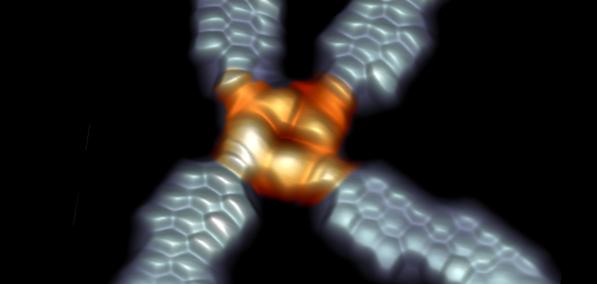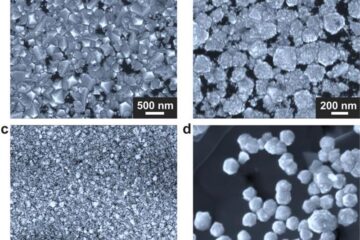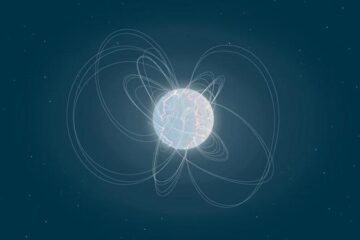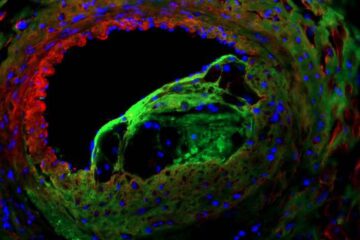Contacting the molecular world through graphene nanoribbons

Scanning Tunneling Microscopy image of the new molecular device and its graphene nanoribbons contacts. Credit: CIC nanoGUNE
And one of the most recent steps forward is appearing today on peer-reviewed journal Science Advances, as a result of a new collaboration between physicists from CIC nanoGUNE, Donostia International Physics Center (DIPC) and Materials Physics Center (CFM, CSIC-UPV/EHU) and synthetic chemists from CiQUS (Center for Research on Biological Chemistry and Molecular Materials at the University of Santiago de Compostela). A breakthrough that has allowed contacting a single-molecule magnetic device for the first time.
“The idea is fascinating: to store information into a single molecule and read it”, says Nacho Pascual, Ikerbasque Professor and leader of the Nanoimaging Group at nanoGUNE. “We have known for long time how to make the molecules, but we could never wire them into a circuit until now”, he confides. To achieve this goal, scientists developed graphene narrow stripes with the aim of using them as electrical wires; in addition, they also designed a method to precisely contact the molecule at predefined places.
“We found that the contact to the molecule crucially affects how the molecular device behaves”, says Jingcheng Li, first author of the article. “This discovery has made us direct the contacting step with atomic precision technologies”.
Regarding the molecule creation process, researchers have employed in this case a chemical method based on guided chemical reactions over a metallic surface. “The creation of the molecular device is simple”, explains CiQUS team leader, Diego Peña: “we designed and synthetized the building blocks with 'glue-like' chemical terminations at the points where contacts are to be created; from then on, nature does the rest of the job for us”, he jokes.
To illustrate the process, this group of scientists has given a very visual metaphor: “we can see it as a molecular LEGO”, they said. In words of Dr. Pascual, “we are learning how to use nature's laws for assembling molecules into more complex nanostructures”, he claims.
The authors demonstrated the working function of the molecular device using Scanning Tunneling Microscopy (STM), a very advanced method to visualize atoms and molecules, and to measure their behavior. By means of this tool, they could confirm under which conditions the magnetic information stored in the molecule could survive to the contact, opening a new way to develop novel materials for efficient electronics.
###
The work has been realized in the framework of a Spanish collaborative research consortium named FunMolDev (acronym of Functional Molecular Devices), funded by the Spanish Ministry for the Economy and Competitiveness, the Government of the Basque Autonomous Community, the Xunta de Galicia, and the European Union.
References
'Survival of spin state in magnetic porphyrins contacted by graphene nanoribbons'
by Jingcheng Li, Nestor Merino-Díez, Eduard Carbonell-Sanromà, Manuel Vilas-Varela, Dimas G. de Oteyza, Diego Peña, Martina Corso, and J.I. Pascual
Media Contact
Irati Kortabitarte
i.kortabitarte@elhuyar.eus
34-943-363-040
Media Contact
All latest news from the category: Materials Sciences
Materials management deals with the research, development, manufacturing and processing of raw and industrial materials. Key aspects here are biological and medical issues, which play an increasingly important role in this field.
innovations-report offers in-depth articles related to the development and application of materials and the structure and properties of new materials.
Newest articles

Making diamonds at ambient pressure
Scientists develop novel liquid metal alloy system to synthesize diamond under moderate conditions. Did you know that 99% of synthetic diamonds are currently produced using high-pressure and high-temperature (HPHT) methods?[2]…

Eruption of mega-magnetic star lights up nearby galaxy
Thanks to ESA satellites, an international team including UNIGE researchers has detected a giant eruption coming from a magnetar, an extremely magnetic neutron star. While ESA’s satellite INTEGRAL was observing…

Solving the riddle of the sphingolipids in coronary artery disease
Weill Cornell Medicine investigators have uncovered a way to unleash in blood vessels the protective effects of a type of fat-related molecule known as a sphingolipid, suggesting a promising new…





















